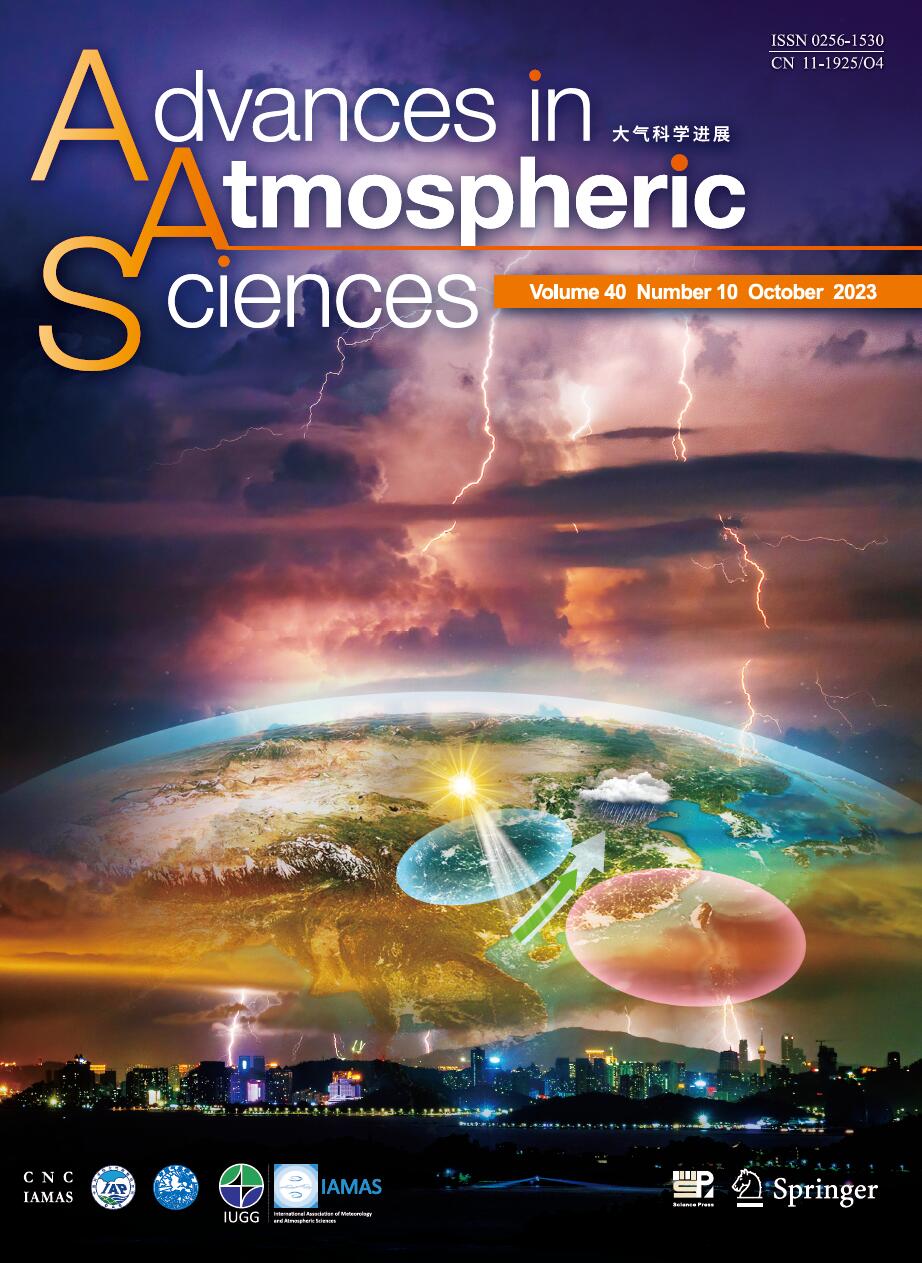| [1] |
YANG Peicai, WANG Geli, BIAN Jianchun, ZHOU Xiuji,
2010: The Prediction of Non-stationary Climate Series Based on Empirical Mode Decomposition, ADVANCES IN ATMOSPHERIC SCIENCES, 27, 845-854.
doi: 10.1007/s00376-009-9128-x
|
| [2] |
WANG Geli, YANG Peicai, ZHOU Xiuji,
2013: Nonstationary Time Series Prediction by Incorporating External Forces, ADVANCES IN ATMOSPHERIC SCIENCES, 30, 1601-1607.
doi: 10.1007/s00376-013-2134-z
|
| [3] |
Wang Shaowu, Zhu Jinhong,
2001: A Review on Seasonal Climate Prediction, ADVANCES IN ATMOSPHERIC SCIENCES, 18, 197-208.
doi: 10.1007/s00376-001-0013-5
|
| [4] |
Zhizhen XU, Jing CHEN, Mu MU, Guokun DAI, Yanan MA,
2022: A Nonlinear Representation of Model Uncertainty in a Convective-Scale Ensemble Prediction System, ADVANCES IN ATMOSPHERIC SCIENCES, 39, 1432-1450.
doi: 10.1007/s00376-022-1341-x
|
| [5] |
YE Liming, YANG Guixia, Eric VAN RANST, TANG Huajun,
2013: Time-Series Modeling and Prediction of Global Monthly Absolute Temperature for Environmental Decision Making, ADVANCES IN ATMOSPHERIC SCIENCES, 30, 382-396.
doi: 10.1007/s00376-012-1252-3
|
| [6] |
JIANG Zhina, MU Mu,
2009: A Comparison Study of the Methods of Conditional Nonlinear Optimal Perturbations and Singular Vectors in Ensemble Prediction, ADVANCES IN ATMOSPHERIC SCIENCES, 26, 465-470.
doi: 10.1007/s00376-009-0465-6
|
| [7] |
Mu Mu, Duan Wansuo, Wang Jiacheng,
2002: The Predictability Problems in Numerical Weather and Climate Prediction, ADVANCES IN ATMOSPHERIC SCIENCES, 19, 191-204.
doi: 10.1007/s00376-002-0016-x
|
| [8] |
WANG Huijun, FAN Ke, SUN Jianqi, LI Shuanglin, LIN Zhaohui, ZHOU Guangqing, CHEN Lijuan, LANG Xianmei, LI Fang, ZHU Yali, CHEN Hong, ZHENG Fei,
2015: A Review of Seasonal Climate Prediction Research in China, ADVANCES IN ATMOSPHERIC SCIENCES, 32, 149-168.
doi: 10.1007/s00376-014-0016-7
|
| [9] |
XIAO Ziniu, LIU Hua, ZHANG De,
2012: Progress in Climate Prediction and Weather Forecast Operations in China, ADVANCES IN ATMOSPHERIC SCIENCES, 29, 943-957.
doi: 10.1007/s00376-012-1194-9
|
| [10] |
Lili LEI, Yangjinxi GE, Zhe-Min TAN, Yi ZHANG, Kekuan CHU, Xin QIU, Qifeng QIAN,
2022: Evaluation of a Regional Ensemble Data Assimilation System for Typhoon Prediction, ADVANCES IN ATMOSPHERIC SCIENCES, 39, 1816-1832.
doi: 10.1007/s00376-022-1444-4
|
| [11] |
Hongqin ZHANG, Xiangjun TIAN, Wei CHENG, Lipeng JIANG,
2020: System of Multigrid Nonlinear Least-squares Four-dimensional Variational Data Assimilation for Numerical Weather Prediction (SNAP): System Formulation and Preliminary Evaluation, ADVANCES IN ATMOSPHERIC SCIENCES, 37, 1267-1284.
doi: 10.1007/s00376-020-9252-1
|
| [12] |
XIA Zhiye, CHEN Hongbin, XU Lisheng, WANG Yongqian,
2015: Extended Range (10-30 Days) Heavy Rain Forecasting Study Based on a Nonlinear Cross-Prediction Error Model, ADVANCES IN ATMOSPHERIC SCIENCES, 32, 1583-1591.
doi: 10.1007/s00376-015-4252-2
|
| [13] |
Wang Huijun, Zhou Guangqing, Zhao Yan,
2000: An Effective Method for Correcting the Seasonal-Interannual Prediction of Summer Climate Anomaly, ADVANCES IN ATMOSPHERIC SCIENCES, 17, 234-240.
doi: 10.1007/s00376-000-0006-9
|
| [14] |
ZHANG Hanbin, CHEN Jing, ZHI Xiefei, WANG Yi, WANG Yanan,
2015: Study on Multi-Scale Blending Initial Condition Perturbations for a Regional Ensemble Prediction System, ADVANCES IN ATMOSPHERIC SCIENCES, 32, 1143-1155.
doi: 10.1007/s00376-015-4232-6
|
| [15] |
Xia LIU, Qiang WANG, Mu MU,
2018: Optimal Initial Error Growth in the Prediction of the Kuroshio Large Meander Based on a High-resolution Regional Ocean Model, ADVANCES IN ATMOSPHERIC SCIENCES, 35, 1362-1371.
doi: 10.1007/s00376-018-8003-z
|
| [16] |
Huijun HUANG, Bin HUANG, Li YI, Chunxia LIU, Jing TU, Guanhuan WEN, Weikang MAO,
2019: Evaluation of the Global and Regional Assimilation and Prediction System for Predicting Sea Fog over the South China Sea, ADVANCES IN ATMOSPHERIC SCIENCES, 36, 623-642.
doi: 10.1007/s00376-019-8184-0
|
| [17] |
Yaodeng Chen, Qihang Yang, Luyao Qin, Yuanbing Wang, Deming Meng, Xusheng Yan,
2024: Impact of Skin Temperature Control Variable on the Assimilation of Microwave Temperature-sounding Channels in Regional Numerical Weather Prediction, ADVANCES IN ATMOSPHERIC SCIENCES.
doi: 10.1007/s00376-024-4070-5
|
| [18] |
Li Maicun, Yao Dirong,
1985: SOME RESULTS OF APPLICATIONS OF STATISTICAL METHOD TO CLIMATE CHANGES AND SHORT-TERM CLIMATE PREDICTION IN CHINA, ADVANCES IN ATMOSPHERIC SCIENCES, 2, 271-281.
doi: 10.1007/BF02677243
|
| [19] |
Hong-Li REN, Qing BAO, Chenguang ZHOU, Jie WU, Li GAO, Lin WANG, Jieru MA, Yao TANG, Yangke LIU, Yujun WANG, Zuosen ZHAO,
2023: Seamless Prediction in China: A Review, ADVANCES IN ATMOSPHERIC SCIENCES, 40, 1501-1520.
doi: 10.1007/s00376-023-2335-z
|
| [20] |
Feifan ZHOU, Munehiko YAMAGUCHI, Xiaohao QIN,
2016: Possible Sources of Forecast Errors Generated by the Global/Regional Assimilation and Prediction System for Landfalling Tropical Cyclones. Part I: Initial Uncertainties, ADVANCES IN ATMOSPHERIC SCIENCES, 33, 841-851.
doi: 10.1007/s00376-016-5238-4
|















 AAS Website
AAS Website 
 AAS WeChat
AAS WeChat 
 DownLoad:
DownLoad: